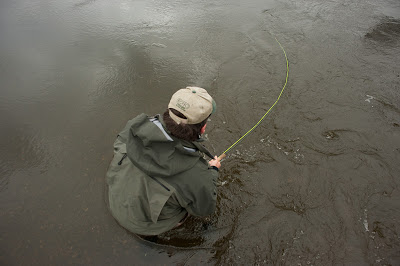In this week’s Deneki Chronicles we revisit Spey Fishing Tactics for Trout, specifically patterns. Give it a read before your trip to Alaska to tag some Big Rainbow Trout.

In the past couple of weeks we’ve covered why we think you should spey fish for trout, and which gear you should use when you do it. Today we’ll talk a bit about tactics to use when chasing rainbows with lightweight two-handers.
Spey rods are fundamentally made for swinging flies, but any fly that can also be stripped is a great candidate for a little two-hander too. If you’re looking for a dead drift, as is typically the case with an insect-imitating dry fly, you’re probably best off sticking with a single-handed rod – that’s just the best tool for the job.
Here are three top fly types and their tactics that work great with a two-handed rod.
Sculpins
Sculpins often dart around in the shallows just off the bank, but they also can get swept downriver in deeper, heavier currents. It’s easy to imitate this behavior with a spey rod. If you’re fishing a piece of water like the lower Arolik where you can hit the far bank with a good cast, do it!
Land that fly as close to the far bank as possible and give it a couple of strips to start. Then mend and let it sink and swing in the heavier current. Finally, when your sculpin pattern reaches the shallow water on the near side of the river, give it some erratic strips again (which you’ll need to do anyhow to retrieve line if you’re fishing a modern Skagit-style spey line). You may get an eat in any of those three parts of your presentation – stripping off the far bank, swinging in the heavy current, or stripping on the near bank – so be ready at all times.
Sculpins are best imitated using a moderate sinktip.
Smolt
In rivers that are loaded with salmon smolt, those juvenille hunks of protein are one of the favorite foods of big rainbows. Smolt tend to hang out in softer water near deeper banks, and they’re going to flee when they detect a big rainbow. That being said, standing near the shallow bank and stripping off the far deep bank is your best bet.
This is a situation in which many quick presentations are going to be more effective than trying to cover a lot of water on each cast. Pitch that smolt pattern at the far bank, give it a few quick strips, and then step down and cast again. Cover the water quickly and strip quickly too.
Salmon smolt typically hang out relatively close to the surface, so use a floating line with a weighted fly, or a light sinktip with a lightly weighted fly, or a moderate sinktip with a real fast strip.
Mice
Mice, lemmings and voles represent big meals for rainbow trout. The visual nature of fishing a mouse pattern, and the fact that big ‘bows move a long way for a mouse, make ‘spey mousing’ one of the most exciting ways to target big rainbows.
Choose your water wisely. Small furry mammals jump (or fall) into the river most frequently near grassy banks. Slow to moderate current speeds and slightly deeper water tend to be best for mouse flies. Don’t bother fishing the mouse in really shallow or fast water.
Slowly swinging a mouse pattern so it creates a classic v-wake can work great. Sometimes rainbows seem to want a little twitchier presentation, so try erratic, short, quick strips as well. Small mammals can’t swim fast, so stay away from long, fast strips.
Mouse patterns are fished on the surface of course, so use a floating tip.
Have fun out there!

Leave a Reply